Market competition is at an all-time high and companies need to create unfair advantages to compete and grow. An interesting growth lever companies can use is data. In today’s world, data is ubiquitous and companies that will leverage it will win.
Data-Driven marketing guide for your marketing strategies.
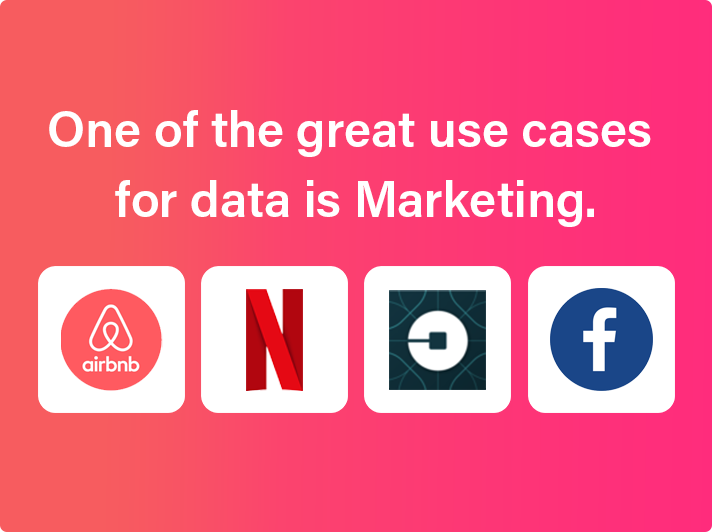
One of the great use cases for data is Marketing.
Data-driven marketing to be exact.
There are a few reasons why you should think about using data for marketing: Data-driven companies win because (1) they understand their customers better than their competitors, (2) they make decisions based on reality, and (3) they move fast.
“In fact, a whopping 64% of executives surveyed by Forbes Insights and Turn “strongly agree” that data-driven marketing is crucial to success in a hyper-competitive global economy.” (Source)
And the results speak for themselves: “Leaders in data-driven marketing are more than six times more likely than laggards to report achieving competitive advantage in increasing profitability (45 percent vs. 7 percent) and five times more likely in customer retention (74 percent vs. 13 percent).” (Source)
Marketing + Data = Opportunity
Data-driven marketing is a huge opportunity for marketers. With the data available to you, you can understand your customers better than ever before and create rich tailored experiences to drive revenue for your business.
Acting on data for marketing can be a real growth lever. To be successful using data you need to have a data process in place that’s working well. Unfortunately for most companies, this is far from the truth. Most companies are still trying to make sense of all the data at their disposal, “72% of respondents are still focused primarily on knowledge gathering rather than making real and actionable use of their data.” (Source)
ROI-Driven Marketing
With great power comes great responsibility and marketers are under more scrutiny than ever before. Technology has evolved to the point where you can track almost every marketing activity and therefore determine if a marketing channel is worthwhile. With that ability, Marketers need to understand and prove the ROI of their campaigns and actions. “93% of CMOs say that they are under more pressure to deliver measurable ROI.” (Source)
However there is still a lot of blur around marketing attribution and how to measure marketing ROI. This is one of the main constraint for marketers – “81% of marketers would increase spending on digital, mobile, and social channels if they could better track ROI.” (Source)
What does data-driven marketing mean?
Data-driven marketing is the process used by marketers to understand their customers and create B2B or B2C campaigns based on the data at their disposal. This data can be both qualitative and quantitative.
It can be further divided into 2 types:
Data-driven marketing as a way to drive and prioritize marketing campaigns with effective marketing strategies.
Example: Using a prioritization framework to decide which marketing campaigns to work on as opposed to a more gut-based approach where you do what you feel like doing.
Other examples:
-
Experimentation-Driven Marketing: Using the scientific method to run your marketing campaigns process: Hypothesis, Experiment, Analysis.
-
New Channel Testing: Launching test for channels to define which one actually works and which one doesn’t.
Example: Using an “email open” event to trigger a target audience with personalized retargeting campaign on Facebook.
Other examples:
-
Lifecycle Messaging: Using a user analytics event to trigger a personalized event to be sent.
- Lifecycle messaging: Using a user scan event to trigger the sending of a custom event to have a conversion .
-
Personalization (Product OR Paid Marketing): Utilizing user traits to segment your audience and display personalized content.
-
Recommendation Engine: Using historical user data to recommend content (articles, products, etc).
-
Segmentation Automation: Utilizing user behaviors and traits to automatically attribute them to the right segment.
-
Cart Abandonment: Utilizing user behaviors to analyse cart abandonment and/or predict most inclined customers to prevent them for abandoning their cart.
The advantages of data-driven marketing
As seen earlier, there are 3 advantages to using Data-Driven Marketing:
-
You will have a better understanding of your customers – Data is the best proxy we have today to analyze customer and new customers behaviors at scale. Understanding your customers will enable you to create better defined marketing campaigns.
-
You will make better decisions – Most of our decisions lack a solid foundation in reality. We make most of our decisions based on incomplete context and/or by analogy. With data you can bridge this knowledge gap and make decisions that are best for your business based on what’s really happening.
-
You will move faster – Data brings confidence and you will be able to act faster than before helped by technology like marketing automation software.
But the reason you should consider investing in data-driven marketing (Inbound marketing, online-marketing, Media marketing, Content marketing, Social media marketing) is because you will learn faster about what works and what doesn’t. You will the be able to incorporate those learnings into your marketing strategy and increase your conversion rates.
This virtuous learning cycle is the pinnacle of data-drivenness.
“Be the best at getting better” – Brian Balfour
However, it is difficult to achieve as it requires 3 things: the right skills, the adequate toolset and the right mindset. Without these you won’t be able to be brutally honest about what are the right things to do and act accordingly.
Data-Driven Marketing: A 7-Step Guide
Before building any marketing campaign, companies need to have a solid marketing foundation. This foundation should include clear objectives and key results, ideal customer profile(s) & strategic messaging. It is only on such solid foundation that effective marketing campaigns can be built.
OKRs enable you to know what is important, when to say yes to opportunities but more importantly, when to say no. Ideal customer profile is all about understanding your customers and building the appropriate strategy. Strategic messaging is a way to clarify what your product/service does well and showcase that clearly to your customers.
1/ Define your One Metric That Matters & OKRs
One of the keys to marketing success is achieving real focus—and having the discipline to maintain it. You may succeed if you’re unfocused, but it’ll be by accident – meaning that you won’t be able to pinpoint what actually works as you go along. You’ll spend a lot more time wandering aimlessly, and the lessons learned are more painful and harder-won. If there’s any secret to success for marketing, it’s focus.
A good way to find out about your “One Metric That Matters” is to find the best proxy for your product’s value. Two questions can help you do just that: What does your product or service do that is the most valuable to your users/customers? How can you measure that?
For Netflix, it’s minutes watched per month. For Evernote, it’s notes taken per week. For Facebook, it’s daily active users. Each of these metrics are intimately correlated with a user getting value. If you watched a lot of different shows and movies on Netflix per month, you are engaged and therefore getting value from the service. However, if you only watch one movie per month, the value you get is far lower – unless you Netflix & Chill.

“Metrics become objectives, objectives become mantra, and mantra composes the verbiage of everyone’s job.” – David Selinger
When you have defined your OMTM, the next question is: How can I improve it?
You can take 2 paths from here:
-
Try everything in no particular order
-
or define what actually will move the needle and work only on that
This is where OKRs are useful.
OKR (Objective and Key Results) is a management methodology that connects the work of employees to the company’s overall strategic plan. Objectives are what you want to accomplish. They should be aligned and supported by the organization, plus aspirational. Key Results explain how you’ll get there. They should be measurable, limited in number and have a deadline.
Q2 OKRs example for a Digital Marketing Manager working for a niche ecommerce: Access Example
Date: April 1st – June 30th (Q2)
Objective: Become the leading ecommerce for [niche name].
Key Results:
- Increase Unique Visitors to 200k per month
- Improve UV to customer conversion rate by 10%
- Increase average order value by 5%
Why does it matter to set OKRs?
Marketing roles can cover a lot of ground and you can find yourself doing a lot of different things but not moving the needle. The idea with OKRs is about defining a clear scope for you to work on. Limiting your available tasks will enable you to be more efficient with your resources (time & budget).
2/ Identify your marketing opportunities
Data-driven marketing is all about finding what works and doing more of it. To do just that you will have to figure out a few things first:
- where does most of your traffic comes from?
- where does your best customers come from?
- what’s your average conversion rate?
- what are the pages that convert better?
- where does your customers drop-off in your funnel?
PS: You should adapt these questions to your specific industry.
With these pieces of information you now have a better understanding of what your customer’s journey looks like and can map your efforts to match that.
If you got different answers to the first two questions; you need to allocate more resources to your best converting channels and do more of that.
If your average conversion rate is below what you expect and you have enough traffic to support it, work on conversion rate optimization. Learn from the pages that convert better. For those pages, if you find out they have low traffic, you will need to improve that.
If you find out that very few people actually convert to paying customers you will have to look for more qualitative data (from customer interviews for example) to get a deeper understanding of the problem. PS: Check the Jobs To Be Done framework before running your interviews, it should help you get a deeper understanding of your customer’s problem.
This is an essential step. At all time, you need to be working on the most impactful thing for your business. Not what you want to be working on or what’s trendy. This this why data is so important, without it you can always find a reason why one or another thing is best to work on. With data there is no debate. If two opportunities seem equally important, just run them through a prioritization framework (see below).
3/ Define your marketing campaigns
When you have identified the best marketing opportunity for your business, it is time to find out what’s possible. The common error here is to get right into the first marketing idea you can think of or the latest trick you read in a blog post.
To make this article as actionable as possible we will simulate working on our Key Result #1 from our OKR example: Increase Unique Visitors to 200k per month.
There’s only a few ways to do that with Marketing: Content, Paid & Virality.
Everything falls more or less under those three categories:
- Content: Email Marketing, Search Engine Optimization, Partnerships, Public Relations, Events
- Paid: Search Engine Advertising, Display Advertising, Retargeting, Influencer Marketing, Offline Advertising
- Virality: Word of mouth, Referral program
Now you have found the marketing campaigns available to you, you will need to select the ones that will be the most impactful and get you closer to your key results.
For that, you will have to create a hypothesis for your marketing campaign.
Why is that?
There are two ways to run marketing campaigns: just do it and see what worked OR define what you want to achieve, execute on it and see if you were successful.
One is lagging indicator – check if a metric moved because of a marketing campaigns. The other is a leading indicator – set to be reached. One confirms what we are looking for, the other drives meaningful behaviors.
By creating a hypothesis before running your marketing campaigns, you draw a line in the sand about what the results should look like. After the marketing campaign, you will be able to see if your assumptions were right or wrong and learn from it no matter the result.
“I never lose. I either win or learn.” – Nelson Mandela
This is the scientific method applied to marketing (the scientific method is a research process in which a problem is identified, relevant data is gathered, a hypothesis is formulated from the data, and the hypothesis is empirically tested).
Here is what a marketing hypothesis looks like:
”IF [Variable], THEN [Result] DUE TO [Rationale].”
”IF [Marketing Campaign Name] is successful, THEN we will drive 15,000 unique visitors to [Ecommerce Site Name] and generate 300 sales for a revenue of 18,000$ DUE TO a better ranking on Google for that specific page” (Source)
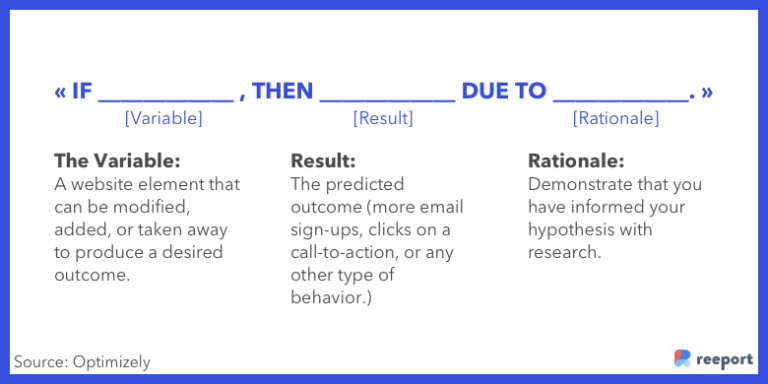
To make sure you stay true to your hypothesis while analyzing your data-driven marketing campaign upon executed, I recommend that you create an experiment document where you record everything in stone. You can check an example of an experiment document here. PS: Open it and make a copy for yourself, by the end of the article, you will have written your first experiment document.
4/ Prioritize your marketing campaigns
You now have a few marketing campaign ideas and a hypothesis for each.
It would be great to just execute on all of them.
But, like everyone, you have limited resources: people, time, and money. This is where prioritization becomes a key part of a data-driven process. To ensure you are working on what matters most at any given time you need to prioritize your marketing campaign ideas.
Several frameworks exist but today we are going to use the ICE Framework and apply it to marketing specifically.
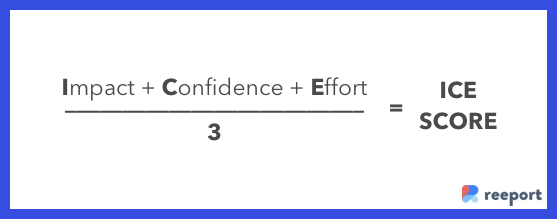
ICE stands for Impact, Confidence & Effort:
- Impact: Is your marketing campaign will be impactful?
Estimation of how much this campaign will move your target customer down the funnel and how many people it will reach.
Give it a grade from 1 to 10. 10 being a massively impactful marketing campaign. 1 being a marketing campaign with a low reach and low impact.
- Confidence: How confident are you in your marketing campaign success?
Estimation of how sure you are about your marketing campaign based on the data available to you. Already done it and you are just changing a few things? Then you should be pretty confident. Never done it or big bet? Then your confidence will be low.
Give it a grade from 1 to 10. 10 being a marketing campaign you have already executed that was successful. 1 being a marketing campaign that you have never done before and have no data to support.
- Effort: How many days and resources will your marketing campaign take to create?
Estimation of the work to be done and the resources needed to actually make this marketing campaign a reality. Take in account your time as a marketer but also the time of your developers and designers. If it’s hard for you to get access to that kind of resources, add a premium to their time.
Give it a grade from 1 to 10. 10 being a marketing campaign that you can do by yourselves in a few hours. 1 being a marketing campaign where you need a full team of designers and engineers for several months.

5/ Execute on your marketing campaigns
You now have a list of marketing campaign ideas that are prioritized. Now is time to execute.
This is where you do your magic as a marketer and where you can really create value for your customers. Marketing technology is an enabler, a facilitator, but execution still trumps it all.
“Ideas are cheap. Ideas are easy. Ideas are common. Everybody has ideas. Ideas are highly, highly overvalued. Execution is all that matters.” – Casey Neistat
Marketing Campaign Execution Process:
- Define your marketing campaign metrics
What marketing metrics your campaign should impact?
By defining them before hand you set yourself for learning. Meaning that you will be able to quickly see if your campaign is working depending.
- Research your marketing campaign idea
Look at similar marketing campaigns to understand what the best practices are. Look for new things that are specific to your marketing campaigns (format, channels, location, etc). Start from there and then expand, don’t copy-paste.
Example: You are running a FB Ads Promotion – Look at what’s working for similar companies, look at companies in other industries, explore Facebook new formats, try new targeting settings, etc.
- Create & Test your Minimum Viable Marketing Campaign
You can learn a lot during the actual process of running your marketing campaign. It would be an error to go all-in just to realize that you weren’t totally right at first. To make sure that doesn’t happen, you can try your marketing idea on a smaller scale so it takes less resources. This is important especially if you need help from a designer or developer to execute your marketing campaign. Why waste everybody’s time when you can run a quick experiment and pre-validate your hypothesis without a line of code?
Example: You are launching an optimized landing page for a new product line you are launching soon. You can either build it from scratch or start by building a mock-up, and, once you get initial feedback on it, build it with Unbounce or a similar tool.
- Create your Marketing Campaign
You now have a good idea of what will work, it’s time to make it live!
For a social media campaign for example, that means building the whole flow of user engagement from the different posts and visuals to the community management process and planning it all to maximize impact and results.
6/ Analyze your marketing campaigns
Congrats! You’ve executed on the most impactful marketing campaign you could execute on.
But how did it go? Was your hypothesis right? Do you need to stop running similar campaigns again? Or have you found a golden opportunity and need to double down?
Analyzing your marketing campaign is one of the core pillars of a data-driven marketing process – without it, you won’t be able to learn what’s working and what needs improvement.
To analyze your marketing campaign, you need to look at data. Most of the time, that means quantitative data. Analytics tools are perfect for that.
There is several solutions available to you:
- Google Analytics lets you measure your advertising ROI as well as track your website, video, and social networking sites and applications:
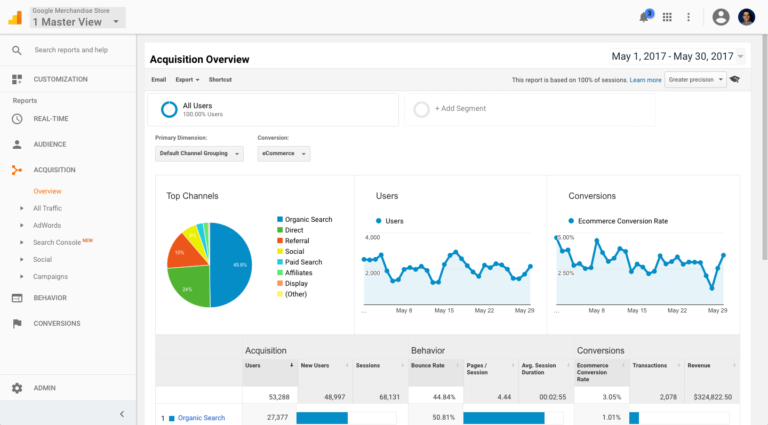
- Reeport lets you visualize multi-source data, explore it, and share the uncovered insights throughout your organization:

Reeport Marketing Dashboard
You previously defined your campaign metrics, took your favorite analytics tool and did a deep-dive. Did you move the needle in the right direction? Or was it a flop?
To make sure you use what you just learned in upcoming marketing campaigns you must do two things:
-
Create Action items to improve follow-up marketing campaigns. What would have you done differently if you had to do it again? What needs to be improved?
-
Create a learnings repository for this specific channel
This is your first data-driven marketing campaign but it’s just the beginning. Right? 🙂
Create a document or a folder where you can write down your learnings about this specific channel. You will be able to come back to it and look at it while researching your next marketing campaign.
7/ Systemize your marketing campaigns
Now that you have understood what works and what doesn’t, you can create a marketing playbook for that channel explaining exactly how to do it step-by-step.
With this marketing playbook at hand, you will be able to save a huge amount of time running similar campaigns but you can also use it to hire someone to take it to another level based on your learnings.
Example of questions you can ask yourself and answer in that document are:
What’s the process looks like? How can you automate it? How can you remove yourself from the equation (Automation? Data?)? How can you remove errors from the process? What are the things that need to be checked or updated before running a similar marketing campaign?
What’s next?
Data is ubiquitous. We are working with it on a daily basis in our job as marketer, however, most of us are not utilizing it to its full potential. Using data-driven marketing will enable you to be more rigorous in your data usage and better equipped for tomorrow’s marketing era – an era built on data.
In that new era of marketing, there will be two types of marketers: the ones willing to use data to inform their work and the one who don’t and build campaigns based on ancient strategies. More importantly, companies will look for people with these skills and mindset to lead their marketing department and help them gain a competitive advantage. It will be even more helpful in non-tech industries where such qualities are not as valued today but will prove to be the most impactful tomorrow.
Are you ready to get on-board the data-driven marketing train? Hop on!
Pour en savoir plus :
- Etre un marketeur Data Driven, ça veut dire quoi ?
- En quoi le Data Driven marketing est-il efficace ?
- Un collaborateur Data Driven, concrètement, c'est quoi ?
- Réussir sa campagne Data Driven marketing : métriques et opportunités
- Une entreprise Data Driven, concrètement, c'est quoi ?
- Data democratization at Airbnb
- La RGPD vous rend Data Driven
- Réussir sa première campagne Data Driven marketing : analyser
- Réussir sa campagne Data Driven marketing : prioriser les campagnes



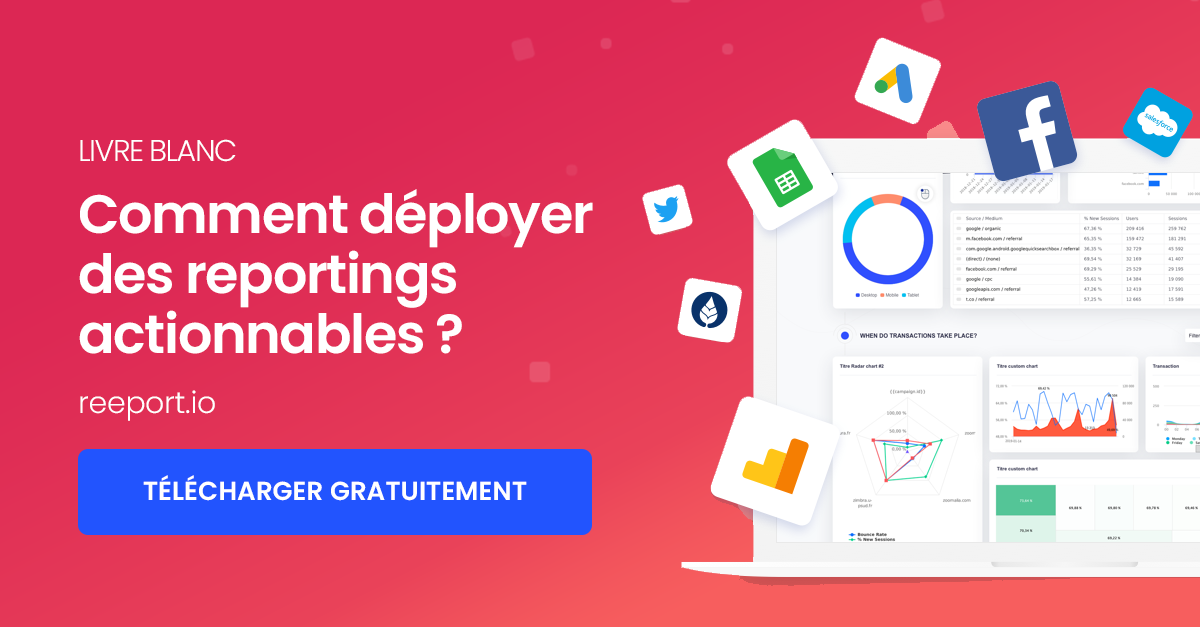
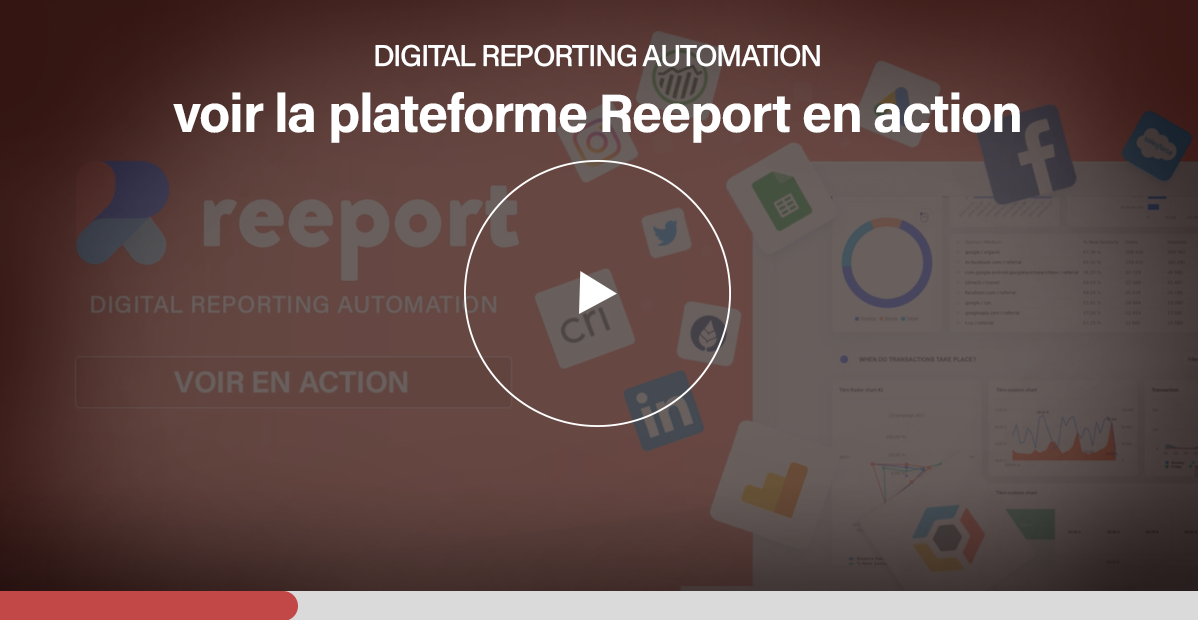

COMMENTAIRES